Fifty infrared shades
I don’t know about you, but I always wondered: what would the world look like if the RGB color channels in the human eye were sensitive to a different range of wavelengths? Rummaging through the bottom of the barrel, I found infrared flashlights (850 and 940nm), a set of IR filters (680-1050nm), a black and white digital camera (no filters at all), 3 lenses (4mm, 6mm and 50mm) calculated for a photo in IR light. Well, let's try to see.
On the topic of IR photos with the removal of the IR filter on Habré already written - this time we will have more opportunities. Also, photos with other wavelengths in the RGB channels (most often with the capture of the IR region) can be seen in posts from Mars and about space in general.
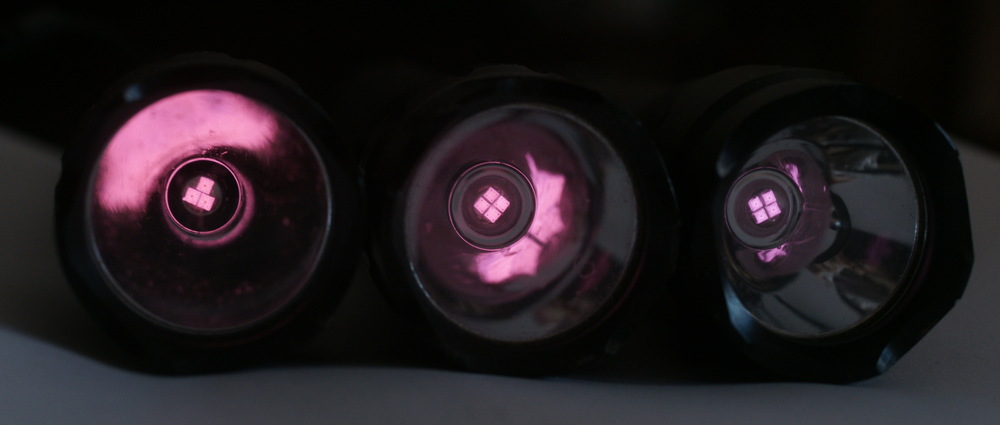
These are torches with IR diodes: 2 left at 850nm, right - at 940nm. The eye sees a faint glow at 840nm, the right one only in complete darkness. For IR cameras, they are dazzling. The eye seems to retain the microscopic sensitivity to the near-IR + LED radiation that comes with less intensity and at shorter (= more visible) wavelengths. Naturally, with powerful IR LEDs, you need to be careful - with luck you can get a burn of the retina unnoticed (as well as from IR lasers) - only that the eye cannot focus radiation at a point can save you.
')
Black and white 5 megapixel noname USB camera - on Aptina Mt9p031 sensor. It shook the Chinese for a long time about black and white cameras - and one seller finally found what I needed. The camera has no filters at all - you can see from 350nm to ~ 1050nm.
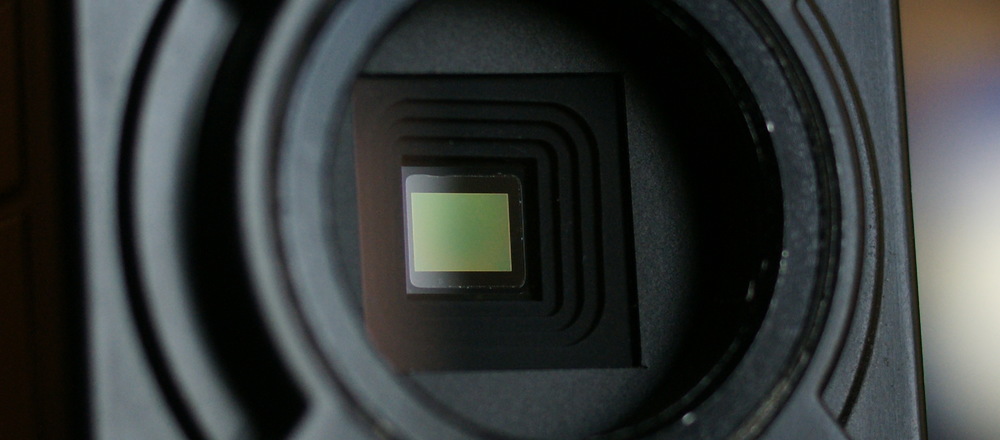
Lenses: this one is 4mm, there are still 6mm and 50mm. On 4 and 6mm - designed for operation in the infrared range - without this, for the infrared range without refocusing, the images would be out of focus (an example would be lower with a conventional camera and infrared radiation of 940nm). It turned out, the bayonet C (and CS with a working segment different by 5 mm) - we also got from 16 mm cameras of the turn of the century. Lenses are still being actively produced - but for video surveillance systems, including well-known companies like Tamron (a 4mm lens just from them: 13FM04IR ).
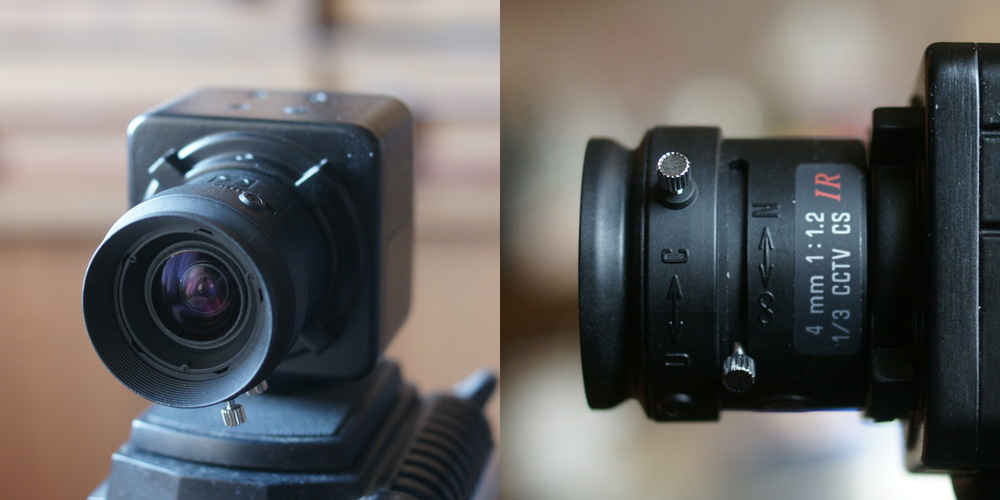
Filters: I found again a set of IR filters from 680 to 1050nm for the Chinese. However, the test for transmitting infrared radiation gave unexpected results - it doesn’t seem like bandpass filters (as I imagined it), but it looks like a different “density” of color - which changes the minimum wavelength of transmitted light. Filters after 850nm turned out to be very dense, and require long exposures. IR-Cut filter - on the contrary, only visible light passes, we need it when shooting money.
Filters in visible light:

Filters in IR: red and green channels - in the light of a 940nm flashlight, blue - 850nm. IR-Cut filter - reflects IR radiation, because it has such a merry color.
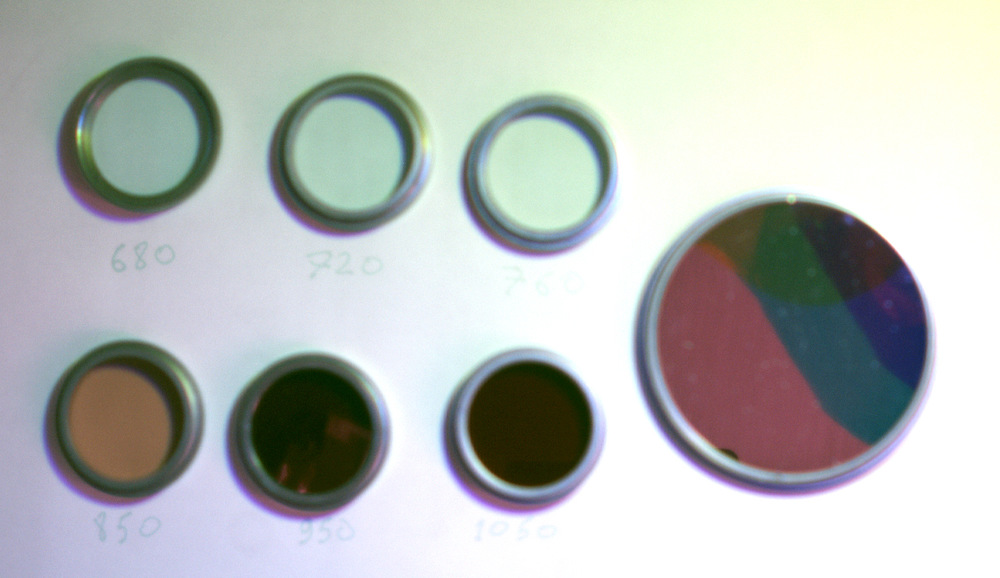
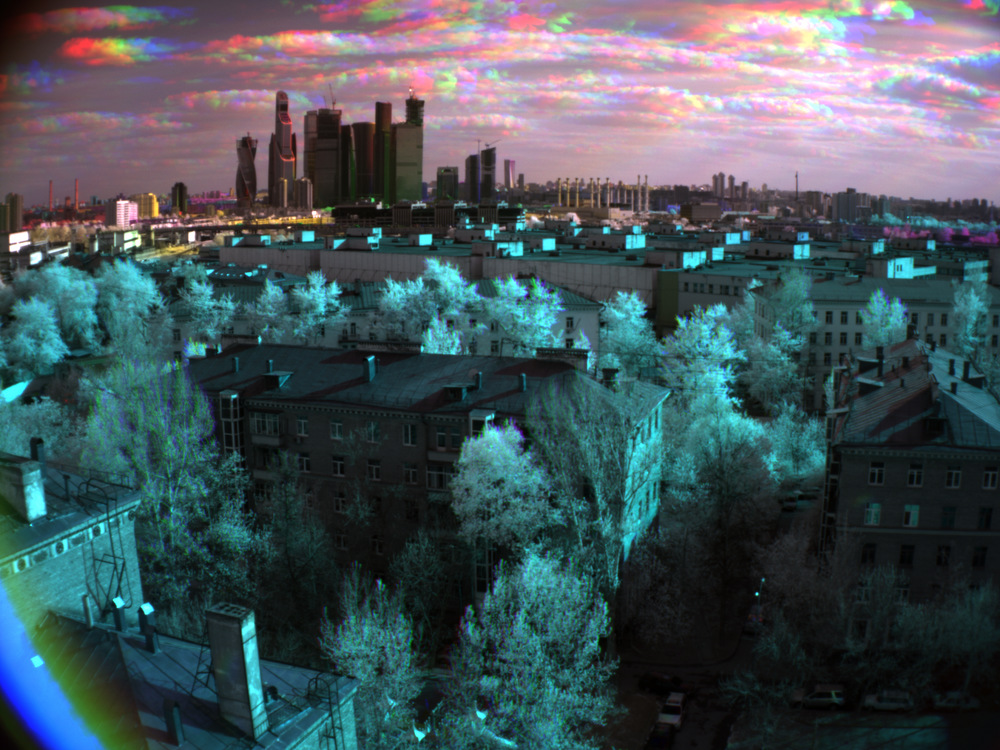
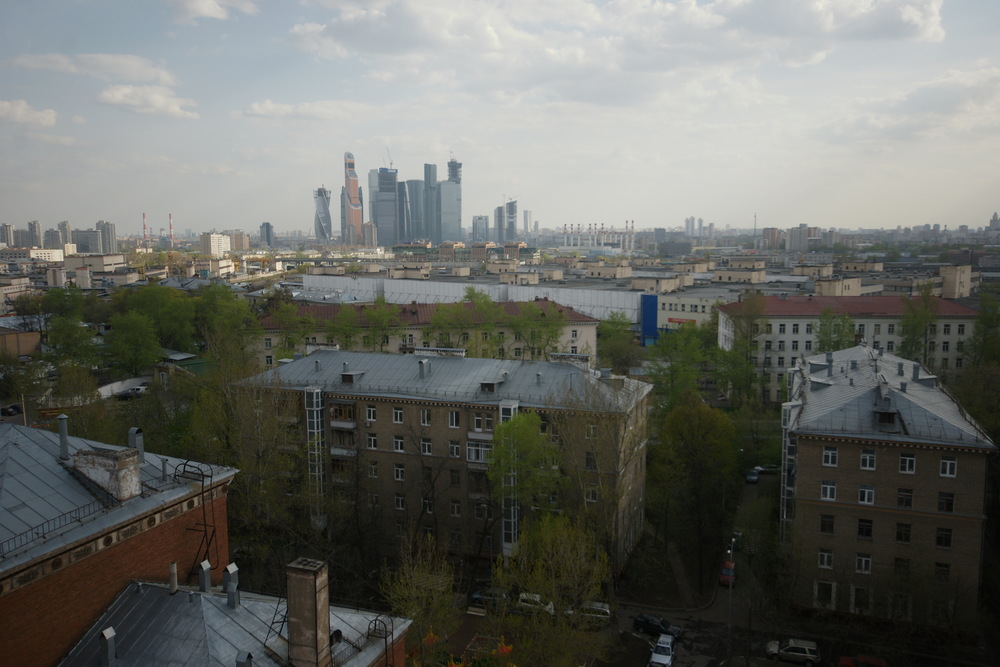
Panorama at night: you can see the difference in the color of different light sources: “energy efficient” - blue, visible only in the nearest IR. Incandescent bulbs - white, shine throughout the range.

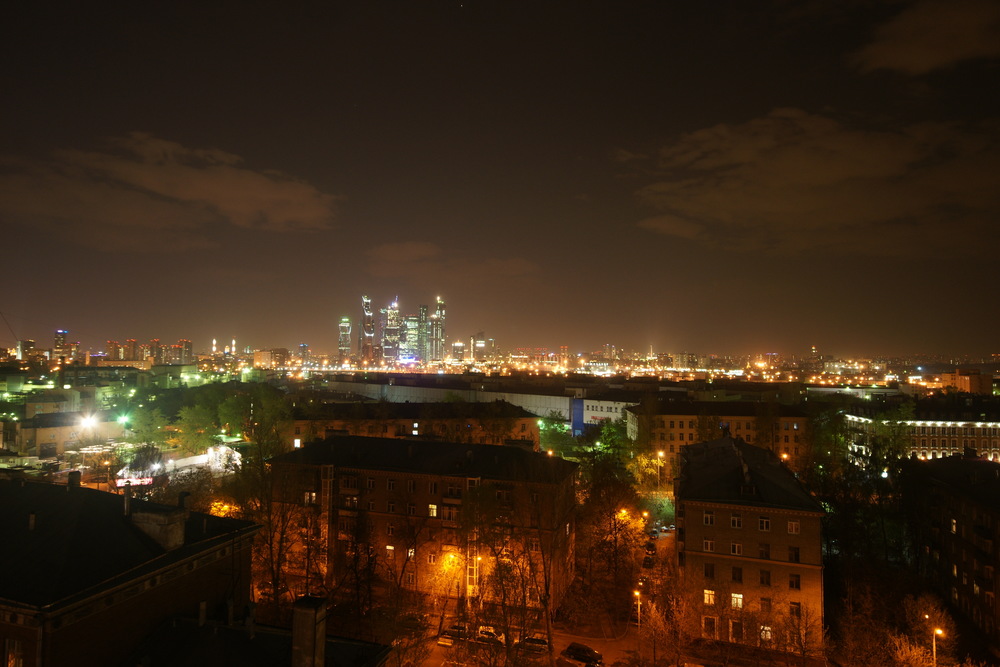
Bookshelf: almost all ordinary objects are almost colorless in IR. Either black or white. Only some paints have a pronounced "blue" (short-wave IR - 760nm) shade. The LCD screen of the game “Well, wait a minute!” - shows nothing in the IR range (although it works for reflection).
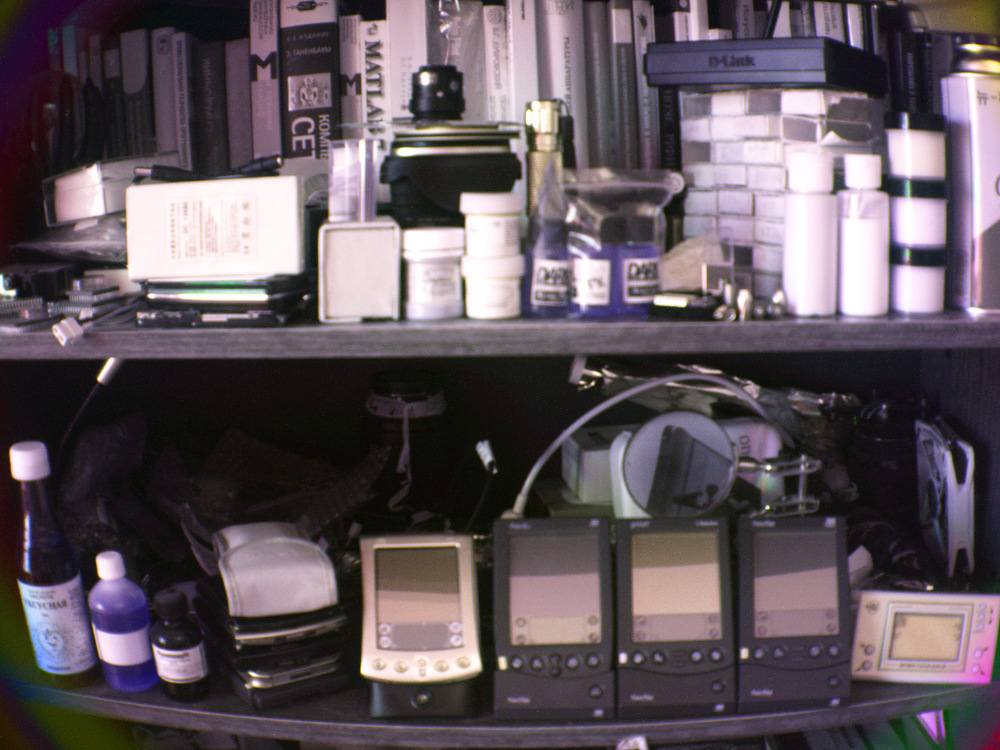

Cell phone with AMOLED screen: absolutely nothing is visible on it in the IR, as well as the blue indicator LED on the stand. In the background - on the LCD screen also can not see anything. The blue paint on the metro ticket is transparent to IR and you can see the antenna for the RFID chip inside the ticket.
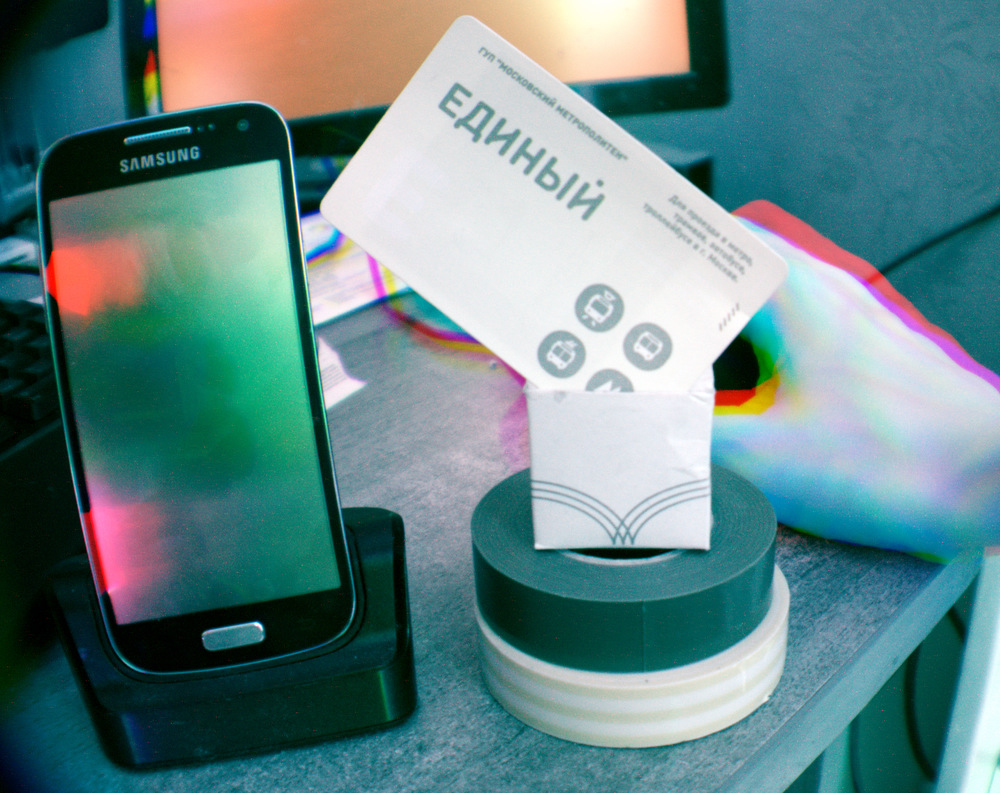

At 400 degrees a soldering iron and a hairdryer glow quite brightly:

Photo of the first star in the evening with an ordinary camera:

IR camera without filter:

IR camera with IR filter: it looks like the signal-to-noise ratio is at least an order of magnitude better; with statistical processing of hundreds and thousands of frames, finding stars during the day may be possible. Shooting in IR can be a salvation for “urban astronomy” - the parasitic illumination of the sky by the city is also much less.

Another example of the first star on the background of the city:
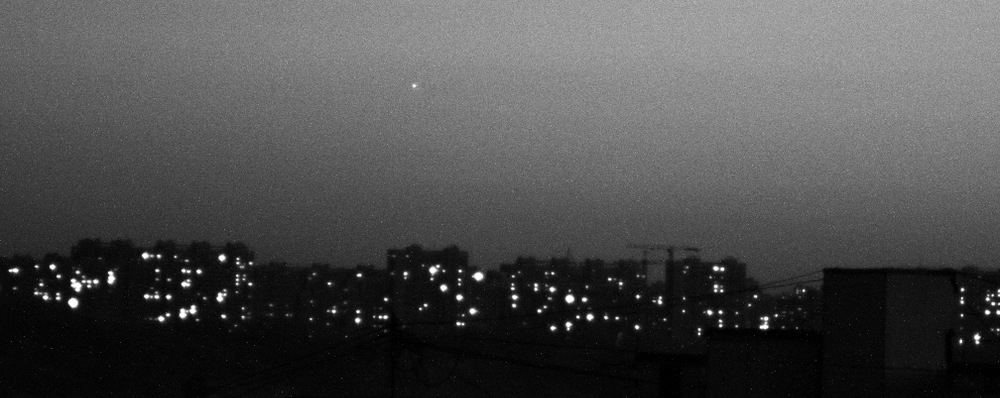
1000 rubles with filters 760, 850 and 1050nm: only certain elements are printed with ink that absorbs infrared radiation:
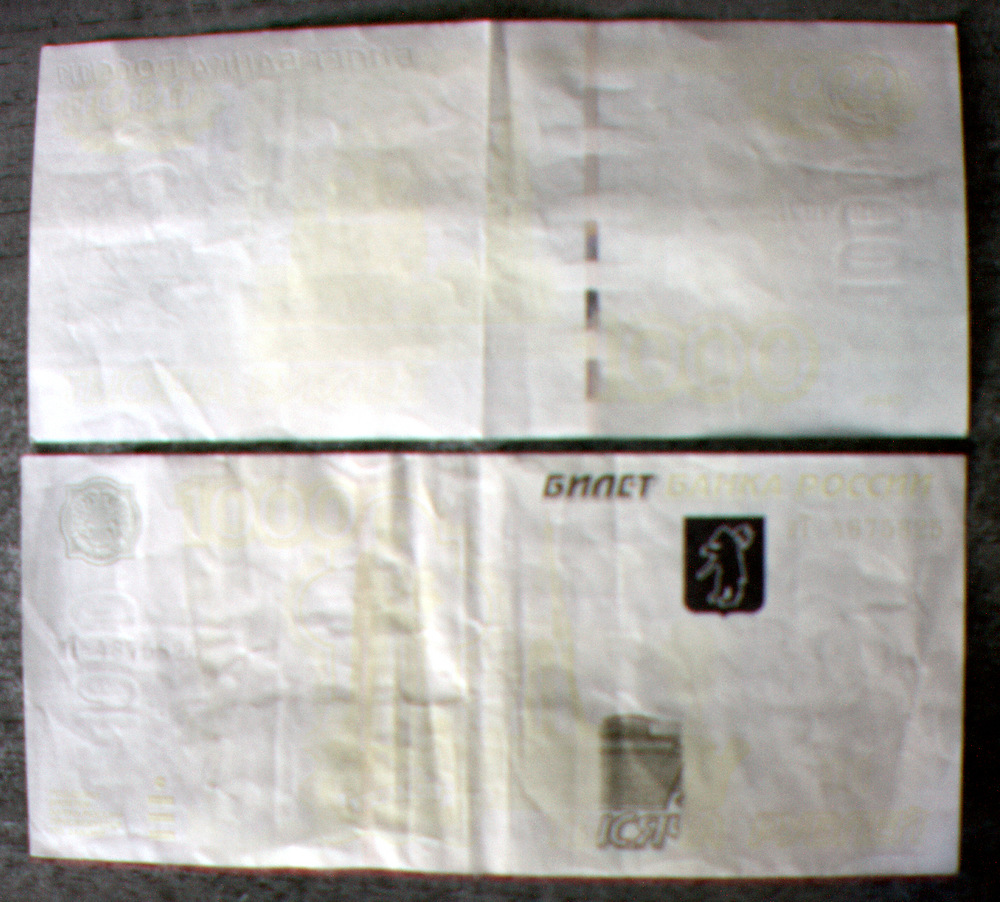
5000 rubles:
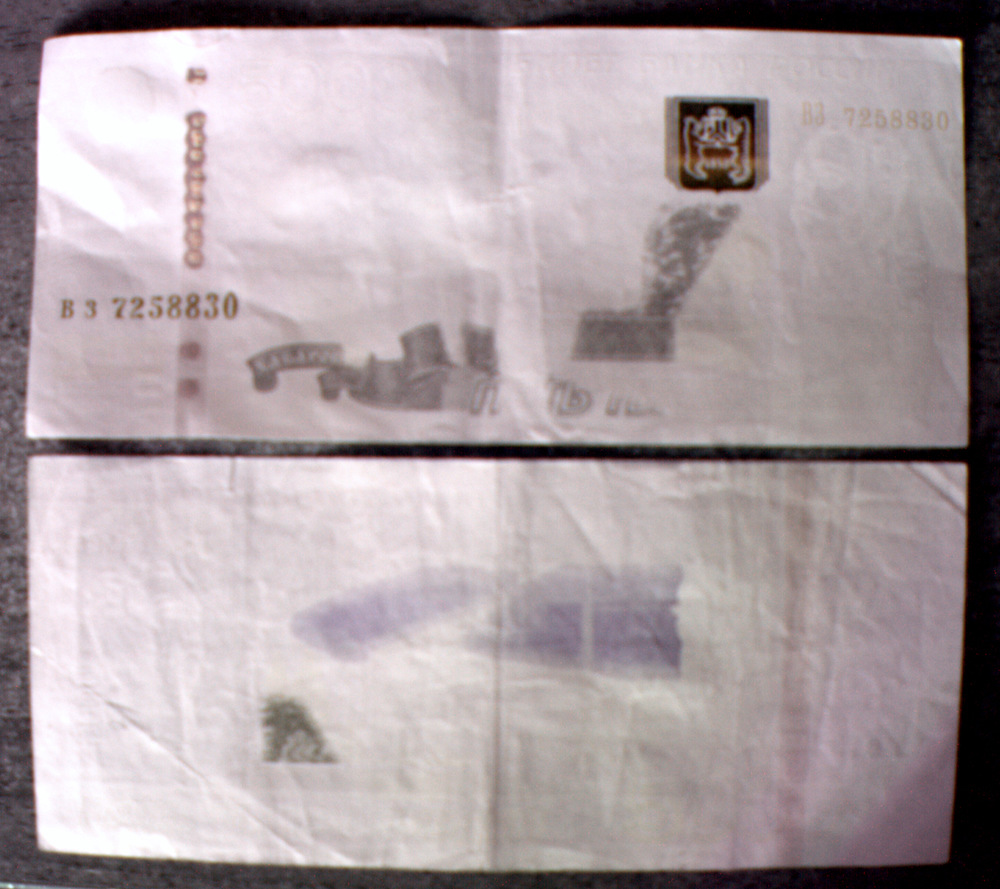
5000 rubles without filters, but with different wavelengths:
red = 940nm, green - 850nm, blue - 625nm (= red light):
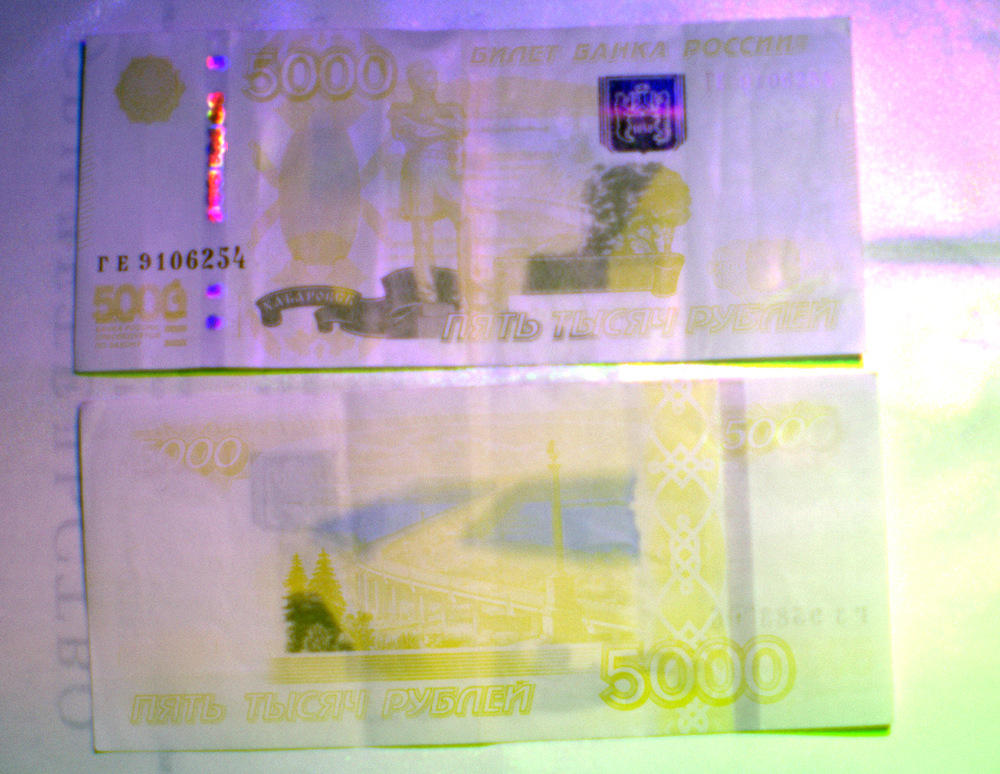
However, infrared money tricks do not end there. There are anti-Stokes marks on bills - when illuminated with IR light of 940nm, they glow in the visible range. A photo with an ordinary camera - as you can see, IR light passes a little through the built-in IR-Cut filter - but since the lens is not optimized for infrared - the image is out of focus. Infrared light looks light lilac because Bayer RGB filters are transparent to IR .
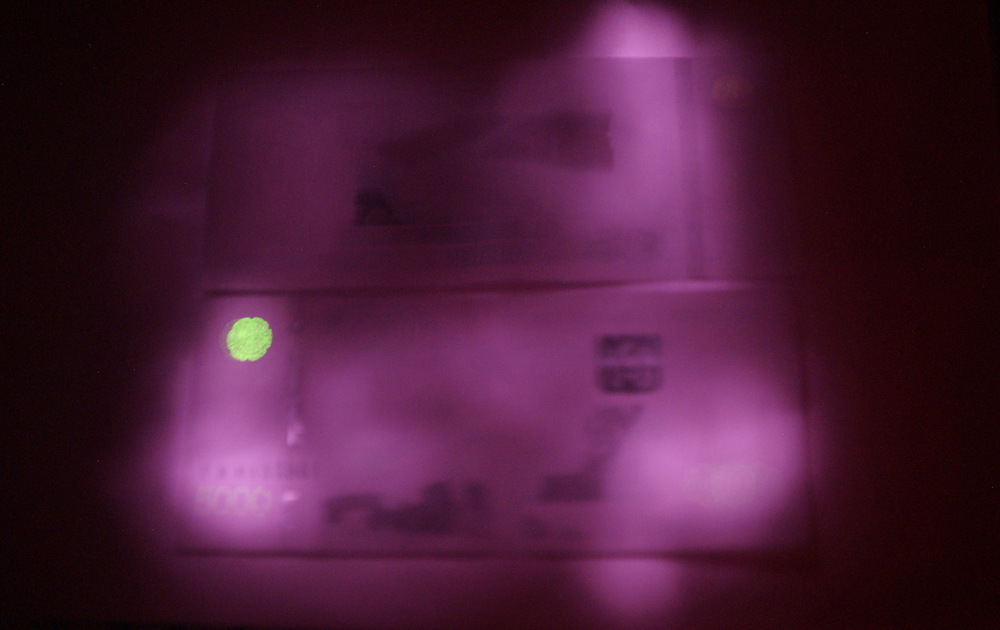
Now, if we add an IR-Cut filter, we will see only glowing anti-Stokes tags. The element above “5000” - glows brightest of all, it can be seen even with not bright room lighting and illumination of 4W 940nm diode / flashlight. This element also contains a red phosphor - it glows for a few seconds after being irradiated with white light (or IR-> green from the anti-Stokes phosphor of the same label).
The element just to the right of the “5000” is a phosphor, glowing green for some time after being irradiated with white light (it does not require IR radiation).
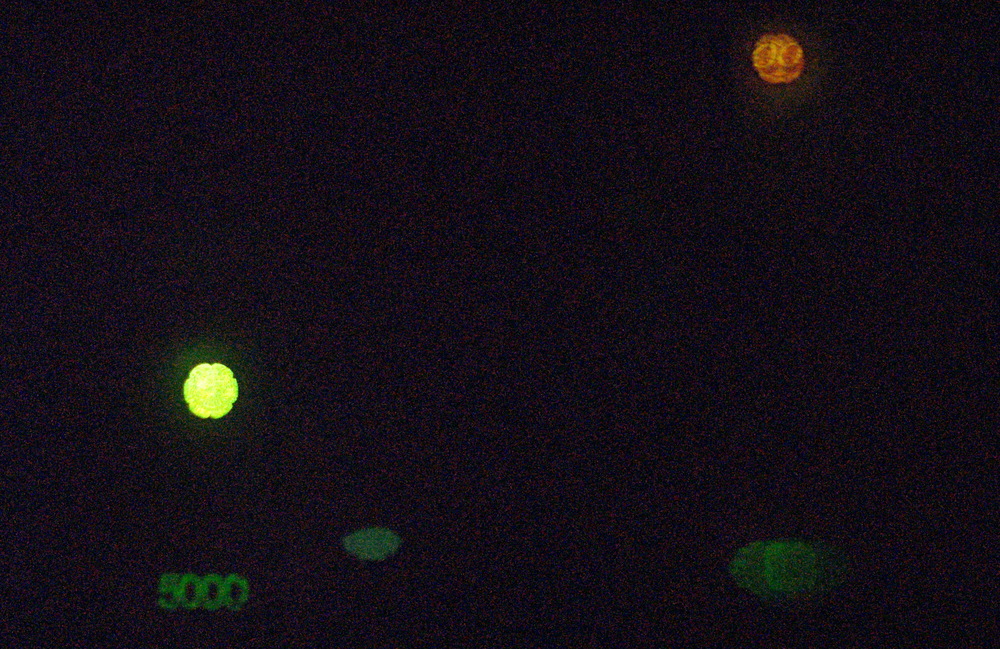
On the topic of IR photos with the removal of the IR filter on Habré already written - this time we will have more opportunities. Also, photos with other wavelengths in the RGB channels (most often with the capture of the IR region) can be seen in posts from Mars and about space in general.

These are torches with IR diodes: 2 left at 850nm, right - at 940nm. The eye sees a faint glow at 840nm, the right one only in complete darkness. For IR cameras, they are dazzling. The eye seems to retain the microscopic sensitivity to the near-IR + LED radiation that comes with less intensity and at shorter (= more visible) wavelengths. Naturally, with powerful IR LEDs, you need to be careful - with luck you can get a burn of the retina unnoticed (as well as from IR lasers) - only that the eye cannot focus radiation at a point can save you.
')
Black and white 5 megapixel noname USB camera - on Aptina Mt9p031 sensor. It shook the Chinese for a long time about black and white cameras - and one seller finally found what I needed. The camera has no filters at all - you can see from 350nm to ~ 1050nm.

Lenses: this one is 4mm, there are still 6mm and 50mm. On 4 and 6mm - designed for operation in the infrared range - without this, for the infrared range without refocusing, the images would be out of focus (an example would be lower with a conventional camera and infrared radiation of 940nm). It turned out, the bayonet C (and CS with a working segment different by 5 mm) - we also got from 16 mm cameras of the turn of the century. Lenses are still being actively produced - but for video surveillance systems, including well-known companies like Tamron (a 4mm lens just from them: 13FM04IR ).

Filters: I found again a set of IR filters from 680 to 1050nm for the Chinese. However, the test for transmitting infrared radiation gave unexpected results - it doesn’t seem like bandpass filters (as I imagined it), but it looks like a different “density” of color - which changes the minimum wavelength of transmitted light. Filters after 850nm turned out to be very dense, and require long exposures. IR-Cut filter - on the contrary, only visible light passes, we need it when shooting money.
Filters in visible light:

Filters in IR: red and green channels - in the light of a 940nm flashlight, blue - 850nm. IR-Cut filter - reflects IR radiation, because it has such a merry color.

Let's start shooting
Panorama by day in the infrared: red channel - with a filter at 1050nm, green - 850nm, blue - 760nm. We see that the trees are particularly well reflect the very near IR. Colored clouds and colored spots on the ground - turned out because of the movement of clouds between frames. Separate frames were combined (if there could be a random camera shift) and stitched together in 1 color picture in CCDStack2 - a program for processing astronomical photos, where color shots are often made from several frames with different filters.

Panorama at night: you can see the difference in the color of different light sources: “energy efficient” - blue, visible only in the nearest IR. Incandescent bulbs - white, shine throughout the range.


Bookshelf: almost all ordinary objects are almost colorless in IR. Either black or white. Only some paints have a pronounced "blue" (short-wave IR - 760nm) shade. The LCD screen of the game “Well, wait a minute!” - shows nothing in the IR range (although it works for reflection).


Cell phone with AMOLED screen: absolutely nothing is visible on it in the IR, as well as the blue indicator LED on the stand. In the background - on the LCD screen also can not see anything. The blue paint on the metro ticket is transparent to IR and you can see the antenna for the RFID chip inside the ticket.


At 400 degrees a soldering iron and a hairdryer glow quite brightly:

Stars
It is known that the sky is blue due to Rayleigh scattering - accordingly, in the IR range, it has a much lower brightness. Is it possible to see the stars in the evening or even in the afternoon against the sky?Photo of the first star in the evening with an ordinary camera:

IR camera without filter:

IR camera with IR filter: it looks like the signal-to-noise ratio is at least an order of magnitude better; with statistical processing of hundreds and thousands of frames, finding stars during the day may be possible. Shooting in IR can be a salvation for “urban astronomy” - the parasitic illumination of the sky by the city is also much less.

Another example of the first star on the background of the city:

Money
The first thing that comes to mind for checking the authenticity of money is UV radiation. However, the bills have a lot of special elements that appear in the IR range, including those visible to the eye. About this on Habré already briefly wrote - now let's see for yourself:1000 rubles with filters 760, 850 and 1050nm: only certain elements are printed with ink that absorbs infrared radiation:

5000 rubles:

5000 rubles without filters, but with different wavelengths:
red = 940nm, green - 850nm, blue - 625nm (= red light):

However, infrared money tricks do not end there. There are anti-Stokes marks on bills - when illuminated with IR light of 940nm, they glow in the visible range. A photo with an ordinary camera - as you can see, IR light passes a little through the built-in IR-Cut filter - but since the lens is not optimized for infrared - the image is out of focus. Infrared light looks light lilac because Bayer RGB filters are transparent to IR .

Now, if we add an IR-Cut filter, we will see only glowing anti-Stokes tags. The element above “5000” - glows brightest of all, it can be seen even with not bright room lighting and illumination of 4W 940nm diode / flashlight. This element also contains a red phosphor - it glows for a few seconds after being irradiated with white light (or IR-> green from the anti-Stokes phosphor of the same label).
The element just to the right of the “5000” is a phosphor, glowing green for some time after being irradiated with white light (it does not require IR radiation).

Summary
Money in the IR range turned out to be extremely tricky, and it is possible to check it in the field not only with UV, but also with IR 940nm flashlight. The results of filming the sky in the IR - give rise to hope for amateur astrophotography without traveling far beyond the city limits.Source: https://habr.com/ru/post/221649/
All Articles